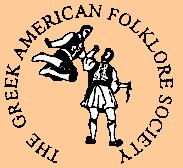Costumes: Dodecanese - Tilos
/This particular woman's costume is worn on festive occasions in "Megalo Horio", on the island of Tilos. The chemise is made of a heavy cotton fabric. The sleeves of the chemise are richly embroidered with red and green silk thread. A red or orange cotton dickey (or bib), intricately stitched, is worn at the opening of the chemise. A light-weight cotton dress, with a very simple design on the back side, is worn over the chemise. The skirt is heavily pleated. Originally a woven red and black striped sash, approximately 7 centimeters in width, was worn around the waist. Today this sash has been replaced by one that is hand-crocheted. Unlike most of the costumes of the surrounding islands, a large, folded scarf is used in place of an apron. During the Italian occupation, however, a small Greek flag was substituted for the scarf (apron). The red velvet headpiece, with pointy shape, is reminiscent of Medieval Times. The base of the head piece is covered with a rectangular, light-weight, cotton scarf. Each end of the scarf is embroidered with a cross-stitch. The scarf is attached to the base of the headpiece by using an elegantly detailed brooch.
In 1991, Paul Ginis traveled to the island of Tilos to conduct his research. Mr. Ginis observed the women still wearing this costume, signing their traditional songs and dancing their traditional dances.


